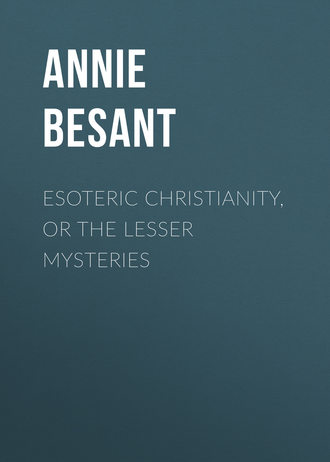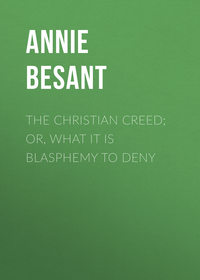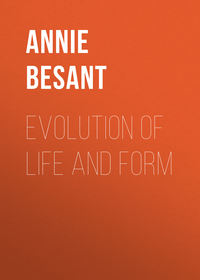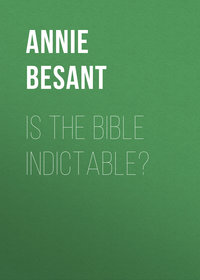 полная версия
полная версияEsoteric Christianity, or The Lesser Mysteries
Now, the Spirit in man is the gift of the Supreme God, and contains within itself the three aspects of the Divine Life – Intelligence, Love, Will – being the Image of God. As it evolves, it first develops the aspect of Intelligence, develops the intellect, and this evolution is effected in the ordinary life in the world. To have done this to a high point, accompanying it with moral development, brings the evolving man to the condition of the candidate. The second aspect of the Spirit is that of Love, and the evolution of that is the evolution of the Christ. In the true Mysteries this evolution is undergone – the disciple's life is the Mystery Drama, and the Great Initiations mark its stages. In the Mysteries performed on the physical plane these used to be dramatically represented, and the ceremonies followed in many respects "the pattern" ever shown forth "on the Mount," for they were the shadows in a deteriorating age of the mighty Realities in the spiritual world.
The Mystic Christ, then, is twofold – the Logos, the Second Person of the Trinity, descending into matter, and the Love, or second, aspect of the unfolding Divine Spirit in man. The one represents kosmic processes carried on in the past and is the root of the Solar Myth; the other represents a process carried on in the individual, the concluding stage of his human evolution, and added many details in the Myth. Both of these have contributed to the Gospel story, and together form the Image of the "Mystic Christ."
Let us consider first the kosmic Christ, Deity becoming enveloped in matter, the becoming incarnate of the Logos, the clothing of God in "flesh."
When the matter which is to form our solar system is separated off from the infinite ocean of matter which fills space, the Third Person of the Trinity – the Holy Spirit – pours His Life into this matter to vivify it, that it may presently take form. It is then drawn together, and form is given to it by the life of the Logos, the Second Person of the Trinity, who sacrifices Himself by putting on the limitations of matter, becoming the "Heavenly Man," in whose Body all forms exist, of whose Body all forms are part. This was the kosmic story, dramatically shown in the Mysteries – in the true Mysteries seen as it occurred in space, in the physical plane Mysteries represented by magical or other means, and in some parts by actors.
These processes are very distinctly stated in the Bible; when the "Spirit of God moved upon the face of the waters" in the darkness that was "upon the face of the deep,"205 the great deep of matter showed no forms, it was void, inchoate. Form was given by the Logos, the Word, of whom it is written that "all things were made by Him; and without Him was not anything made that was made."206 C. W. Leadbeater has well put it: "The result of this first great outpouring [the 'moving' of the Spirit] is the quickening of that wonderful and glorious vitality which pervades all matter (inert though it may seem to our dim physical eyes), so that the atoms of the various planes develop, when electrified by it, all sorts of previously latent attractions and repulsions, and enter into combinations of all kinds."207
Only when this work of the Spirit has been done can the Logos, the kosmic Mystic Christ, take on Himself the clothing of matter, entering in very truth the Virgin's womb, the womb of Matter as yet virgin, unproductive. This matter had been vivified by the Holy Spirit, who, overshadowing the Virgin, poured into it His life, thus preparing it to receive the life of the Second Logos, who took this matter as the vehicle for His energies. This is the becoming incarnate of the Christ, the taking flesh – "Thou did'st not despise the Virgin's womb."
In the Latin and English translations of the original Greek text of the Nicene Creed, the phrase which describes this phase of the descent has changed the prepositions and so changed the sense. The original ran: "and was incarnate of the Holy Ghost and the Virgin Mary," whereas the translation reads: "and was incarnate by the Holy Ghost of the Virgin Mary."208 The Christ "takes form not of the 'Virgin' matter alone, but of matter which is already instinct and pulsating with the life of the Third Logos,209 so that both the life and the matter surround Him as a vesture."210
This is the descent of the Logos into matter, described as the birth of the Christ of a Virgin, and this, in the Solar Myth, becomes the birth of the Sun-God as the sign Virgo rises.
Then come the early workings of the Logos in matter, aptly typified by the infancy of the myth. To all the feebleness of infancy His majestic powers bow themselves, letting but little play forth on the tender forms they ensoul. Matter imprisons, seems as though threatening to slay, its infant King, whose glory is veiled by the limitations He has assumed. Slowly He shapes it towards high ends, and lifts it into manhood, and then stretches Himself on the cross of matter that He may pour forth from that cross all the powers of His surrendered life. This is the Logos of whom Plato said that He was in the figure of a cross on the universe; this is the Heavenly Man, standing in space, with arms outstretched in blessing; this is the Christ crucified, whose death on the cross of matter fills all matter with His life. Dead He seems and buried out of sight, but He rises again clothed in the very matter in which He seemed to perish, and carries up His body of now radiant matter into heaven, where it receives the downpouring life of the Father, and becomes the vehicle of man's immortal life. For it is the life of the Logos which forms the garment of the Soul in man, and He gives it that men may live through the ages and grow to the measure of His own stature. Truly are we clothed in Him, first materially and then spiritually. He sacrificed Himself to bring many sons into glory, and He is with us always, even to the end of the age.
The crucifixion of Christ, then, is part of the great kosmic sacrifice, and the allegorical representation of this in the physical Mysteries, and the sacred symbol of the crucified man in space, became materialised into an actual death by crucifixion, and a crucifix bearing a dying human form; then this story, now the story of a man, was attached to the Divine Teacher, Jesus, and became the story of His physical death, while the birth from a Virgin, the danger-encircled infancy, the resurrection and ascension, became also incidents in His human life. The Mysteries disappeared, but their grandiose and graphic representations of the kosmic work of the Logos encircled and uplifted the beloved figure of the Teacher of Judæa, and the kosmic Christ of the Mysteries, with the lineaments of the Jesus of history, thus became the central Figure of the Christian Church.
But even this was not all; the last touch of fascination is added to the Christ-story by the fact that there is another Christ of the Mysteries, close and dear to the human heart – the Christ of the human Spirit, the Christ who is in every one of us, is born and lives, is crucified, rises from the dead, and ascends into heaven, in every suffering and triumphant "Son of Man."
The life-story of every Initiate into the true, the heavenly Mysteries, is told in its salient features in the Gospel biography. For this reason, S. Paul speaks as we have seen211 of the birth of the Christ in the disciple, and of His evolution and His full stature therein. Every man is a potential Christ, and the unfolding of the Christ-life in a man follows the outline of the Gospel story in its striking incidents, which we have seen to be universal, and not particular.
There are five great Initiations in the life of a Christ, each one marking a stage in the unfolding of the Life of Love. They are given now, as of old, and the last marks the final triumph of the Man who has developed into Divinity, who has transcended humanity, and has become a Saviour of the world.
Let us trace this life-story, ever newly repeated in spiritual experience, and see the Initiate living out the life of the Christ.
At the first great Initiation the Christ is born in the disciple; it is then that he realises for the first time in himself the outpouring of the divine Love, and experiences that marvellous change which makes him feel himself to be one with all that lives. This is the "Second Birth," and at that birth the heavenly ones rejoice, for he is born into "the kingdom of heaven," as one of the "little ones," as "a little child" – the names ever given to the new Initiates. Such is the meaning of the words of Jesus, that a man must become a little child to enter into the Kingdom.212 It is significantly said in some of the early Christian writers that Jesus was "born in a cave" – the "stable" of the gospel narrative; the "Cave of Initiation" is a well-known ancient phrase, and the Initiate is ever born therein; over that cave "where the young child" is burns the "Star of Initiation," the Star that ever shines forth in the East when a Child-Christ is born. Every such child is surrounded by perils and menaces, strange dangers that befall not other babes; for he is anointed with the chrism of the second birth and the Dark Powers of the unseen world ever seek his undoing. Despite all trials, however, he grows into manhood, for the Christ once born can never perish, the Christ once beginning to develop can never fail in his evolution; his fair life expands and grows, ever-increasing in wisdom and in spiritual stature, until the time comes for the second great Initiation, the Baptism of the Christ by Water and the Spirit, that gives him the powers necessary for the Teacher, who is to go forth and labour in the world as "the beloved Son."
Then there descends upon him in rich measure the divine Spirit, and the glory of the unseen Father pours down its pure radiance on him; but from that scene of blessing is he led by the Spirit into the wilderness and is once more exposed to the ordeal of fierce temptations. For now the powers of the Spirit are unfolding themselves in him, and the Dark Ones strive to lure him from his path by these very powers, bidding him use them for his own helping instead of resting on his Father in patient trust. In the swift, sudden transitions which test his strength and faith, the whisper of the embodied Tempter follows the voice of the Father, and the burning sands of the wilderness scorch the feet erstwhile laved in the cool waters of the holy river. Conqueror over these temptations he passes into the world of men to use for their helping the powers he would not put forth for his own needs, and he who would not turn one stone to bread for the stilling of his own cravings feeds "five thousand men, besides women and children," with a few loaves.
Into his life of ceaseless service comes another brief period of glory, when he ascends "a high mountain apart" – the sacred Mount of Initiation. There he is transfigured and there meets some of his great Forerunners, the Mighty Ones of old who trod where he now is treading. He passes thus the third great Initiation, and then the shadow of his coming Passion falls on him, and he steadfastly sets his face to go to Jerusalem – repelling the tempting words of one of his disciples – Jerusalem, where awaits him the baptism of the Holy Ghost and of Fire. After the Birth, the attack by Herod; after the Baptism, the temptation in the wilderness; after the Transfiguration, the setting forth towards the last stage of the Way of the Cross. Thus is triumph ever followed by ordeal, until the goal is reached.
Still grows the life of love, ever fuller and more perfect, the Son of Man shining forth more clearly as the Son of God, until the time draws near for his final battle; and the fourth great Initiation leads him in triumph into Jerusalem, into sight of Gethsemane and Calvary. He is now the Christ ready to be offered, ready for the sacrifice on the cross. He is now to face the bitter agony in the Garden, where even his chosen ones sleep while he wrestles with his mortal anguish, and for a moment prays that the cup may pass from his lips; but the strong will triumphs and he stretches out his hand to take and drink, and in his loneliness an angel comes to him and strengthens him, as angels are wont to do when they see a Son of Man bending beneath his load of agony. The drinking of the bitter cup of betrayal, of desertion, of denial, meets him as he goes forth, and alone amid his jeering foes he passes to his last fierce trial. Scourged by physical pain, pierced by cruel thorns of suspicion, stripped of his fair garments of purity in the eyes of the world, left in the hands of his foes, deserted apparently by God and man, he endures patiently all that befalls him, wistfully looking in his last extremity for aid. Left still to suffer, crucified, to die to the life of form, to surrender all life that belongs to the lower world, surrounded by triumphant foes who mock him, the last horror of great darkness envelopes him, and in the darkness he meets all the forces of evil; his inner vision is blinded, he finds himself alone, utterly alone, till the strong heart, sinking in despair, cries out to the Father who seems to have abandoned him, and the human soul faces, in uttermost loneliness, the crushing agony of apparent defeat. Yet, summoning all the strength of the "unconquerable spirit," the lower life is yielded up, its death is willingly embraced, the body of desire is abandoned, and the Initiate "descends into hell," that no region of the universe he is to help may remain untrodden by him, that none may be too outcast to be reached by his all-embracing love. And then springing upwards from the darkness, he sees the light once more, feels himself again as the Son, inseparable from the Father whose he is, rises to the life that knows no ending, radiant in the consciousness of death faced and overcome, strong to help to the uttermost every child of man, able to pour out his life into every struggling soul. Among his disciples he remains awhile to teach, unveiling to them the mysteries of the spiritual worlds, preparing them also to tread the path he has trodden, until, the earth-life over, he ascends to the Father, and, in the fifth great Initiation, becomes the Master triumphant, the link between God and man.
Such was the story lived through in the true Mysteries of old and now, and dramatically pourtrayed in symbols in the physical plane Mysteries, half veiled, half shown. Such is the Christ of the Mysteries in His dual aspect, Logos and man, kosmic and individual. Is it any wonder that this story, dimly felt, even when unknown, by the mystic, has woven itself into the heart, and served as an inspiration to all noble living? The Christ of the human heart is, for the most part, Jesus seen as the mystic human Christ, struggling, suffering, dying, finally triumphant, the Man in whom humanity is seen crucified and risen, whose victory is the promise of victory to every one who, like Him, is faithful through death and beyond – the Christ who can never be forgotten while He is born again and again in humanity, while the world needs Saviours, and Saviours give themselves for men.
Chapter VII.
THE ATONEMENT
We will now proceed to study certain aspects of the Christ-Life, as they appear among the doctrines of Christianity. In the exoteric teachings they appear as attached only to the Person of the Christ; in the esoteric they are seen as belonging indeed to Him, since in their primary, their fullest and deepest meaning they form part of the activities of the Logos, but as being only secondarily reflected in the Christ, and therefore also in every Christ-Soul that treads the way of the Cross. Thus studied they will be seen to be profoundly true, while in their exoteric form they often bewilder the intelligence and jar the emotions.
Among these stands prominently forward the doctrine of the Atonement; not only has it been a point of bitter attack from those outside the pale of Christianity, but it has wrung many sensitive consciences within that pale. Some of the most deeply Christian thinkers of the last half of the nineteenth century have been tortured with doubts as to the teaching of the churches on this matter, and have striven to see, and to present it, in a way that softens or explains away the cruder notions based on an unintelligent reading of a few profoundly mystical texts. Nowhere, perhaps, more than in connection with these should the warning of S. Peter be borne in mind: "Our beloved brother Paul also, according to the wisdom given unto him, hath written unto you – as also in all his epistles – speaking in them of these things; in which are some things hard to be understood, which they that are unlearned and unstable wrest, as they do also the other scriptures, unto own destruction."213 For the texts that tell of the identity of the Christ with His brother-men have been wrested into a legal substitution of Himself for them, and have thus been used as an escape from the results of sin, instead of as an inspiration to righteousness.
The general teaching in the Early Church on the doctrine of the Atonement was that Christ, as the Representative of Humanity, faced and conquered Satan, the representative of the Dark Powers, who held humanity in bondage, wrested his captive from him, and set him free. Slowly, as Christian teachers lost touch with spiritual truths, and they reflected their own increasing intolerance and harshness on the pure and loving Father of the teachings of the Christ, they represented Him as angry with man, and the Christ was made to save man from the wrath of God instead of from the bondage of evil. Then legal phrases intruded, still further materialising the once spiritual idea, and the "scheme of redemption" was forensically outlined. "The seal was set on the 'redemption scheme' by Anselm in his great work, Cur Deus Homo, and the doctrine which had been slowly growing into the theology of Christendom was thenceforward stamped with the signet of the Church. Roman Catholics and Protestants, at the time of the Reformation, alike believed in the vicarious and substitutionary character of the atonement wrought by Christ. There is no dispute between them on this point. I prefer to allow the Christian divines to speak for themselves as to the character of the atonement… Luther teaches that 'Christ did truly and effectually feel for all mankind the wrath of God, malediction, and death.' Flavel says that 'to wrath, to the wrath of an infinite God without mixture, to the very torments of hell, was Christ delivered, and that by the hand of his own father.' The Anglican homily preaches that 'sin did pluck God out of heaven to make him feel the horrors and pains of death,' and that man, being a firebrand of hell and a bondsman of the devil, 'was ransomed by the death of his only and well-beloved son'; the 'heat of his wrath,' 'his burning wrath,' could only be 'pacified' by Jesus, 'so pleasant was the sacrifice and oblation of his son's death.' Edwards, being logical, saw that there was a gross injustice in sin being twice punished, and in the pains of hell, the penalty of sin, being twice inflicted, first on Jesus, the substitute of mankind, and then on the lost, a portion of mankind; so he, in common with most Calvinists, finds himself compelled to restrict the atonement to the elect, and declared that Christ bore the sins, not of the world, but of the chosen out of the world; he suffers 'not for the world, but for them whom thou hast given me.' But Edwards adheres firmly to the belief in substitution, and rejects the universal atonement for the very reason that 'to believe Christ died for all is the surest way of proving that he died for none in the sense Christians have hitherto believed.' He declares that 'Christ suffered the wrath of God for men's sins'; that 'God imposed his wrath due unto, and Christ underwent the pains of hell for,' sin. Owen regards Christ's sufferings as 'a full valuable compensation to the justice of God for all the sins' of the elect, and says that he underwent 'that same punishment which … they themselves were bound to undergo.'"214
To show that these views were still authoritatively taught in the churches, I wrote further: "Stroud makes Christ drink 'the cup of the wrath of God.' Jenkyn says 'He suffered as one disowned and reprobated and forsaken of God.' Dwight considers that he endured God's 'hatred and contempt.' Bishop Jeune tells us that 'after man had done his worst, worse remained for Christ to bear. He had fallen into his father's hands.' Archbishop Thomson preaches that 'the clouds of God's wrath gathered thick over the whole human race: they discharged themselves on Jesus only.' He 'becomes a curse for us and a vessel of wrath.' Liddon echoes the same sentiment: 'The apostles teach that mankind are slaves, and that Christ on the cross is paying their ransom. Christ crucified is voluntarily devoted and accursed'; he even speaks of 'the precise amount of ignominy and pain needed for the redemption,' and says that the 'divine victim' paid more than was absolutely necessary."215
These are the views against which the learned and deeply religious Dr. McLeod Campbell wrote his well-known work, On the Atonement, a volume containing many true and beautiful thoughts; F. D. Maurice and many other Christian men have also striven to lift from Christianity the burden of a doctrine so destructive of all true ideas as to the relations between God and man.
None the less, as we look backwards over the effects produced by this doctrine, we find that belief in it, even in its legal – and to us crude exoteric – form, is connected with some of the very highest developments of Christian conduct, and that some of the noblest examples of Christian manhood and womanhood have drawn from it their strength, their inspiration, and their comfort. It would be unjust not to recognise this fact. And whenever we come upon a fact that seems to us startling and incongruous, we do well to pause upon that fact, and to endeavour to understand it. For if this doctrine contained nothing more than is seen in it by its assailants inside and outside the churches, if it were in its true meaning as repellent to the conscience and the intellect as it is found to be by many thoughtful Christians, then it could not possibly have exercised over the minds and hearts of men a compelling fascination, nor could it have been the root of heroic self-surrenders, of touching and pathetic examples of self-sacrifice in the service of man. Something more there must be in it than lies on the surface, some hidden kernel of life which has nourished those who have drawn from it their inspiration. In studying it as one of the Lesser Mysteries we shall find the hidden life which these noble ones have unconsciously absorbed, these souls which were so at one with that life that the form in which it was veiled could not repel them.
When we come to study it as one of the Lesser Mysteries, we shall feel that for its understanding some spiritual development is needed, some opening of the inner eyes. To grasp it requires that its spirit should be partly evolved in the life, and only those who know practically something of the meaning of self-surrender will be able to catch a glimpse of what is implied in the esoteric teaching on this doctrine, as the typical manifestation of the Law of Sacrifice. We can only understand it as applied to the Christ, when we see it as a special manifestation of the universal law, a reflection below of the Pattern above, showing us in a concrete human life what sacrifice means.
The Law of Sacrifice underlies our system and all systems, and on it all universes are builded. It lies at the root of evolution, and alone makes it intelligible. In the doctrine of the Atonement it takes a concrete form in connection with men who have reached a certain stage in spiritual development, the stage that enables them to realise their oneness with humanity, and to become, in very deed and truth, Saviours of men.
All the great religions of the world have declared that the universe begins by an act of sacrifice, and have incorporated the idea of sacrifice into their most solemn rites. In Hinduism, the dawn of manifestation is said to be by sacrifice,216 mankind is emanated with sacrifice,217 and it is Deity who sacrifices Himself;218 the object of the sacrifice is manifestation; He cannot become manifest unless an act of sacrifice be performed, and inasmuch as nothing can be manifest until He manifests,219 the act of sacrifice is called "the dawn" of creation.
In the Zoroastrian religion it was taught that in the Existence that is boundless, unknowable, unnameable, sacrifice was performed and manifest Deity appeared; Ahura-mazdâo was born of an act of sacrifice.220






